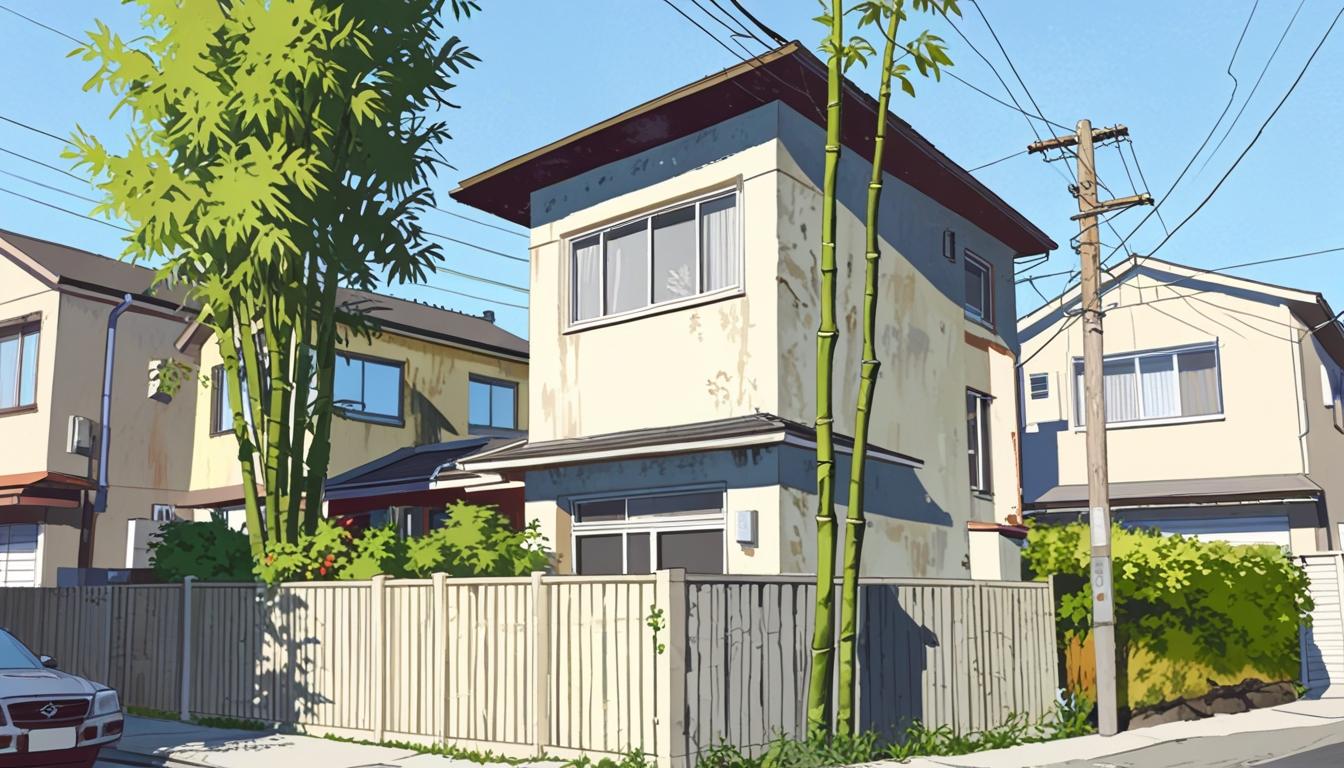Homeowners in Australia and the UK are facing mounting financial and legal challenges as the rapid growth and destructive roots of bamboo encroach on properties, disrupting neighbourhoods and sparking a surge in disputes and removal costs.
It seems that the tranquil coexistence of neighbours is increasingly being threatened by an unexpected adversary: bamboo. Once considered an exotic addition to gardens, this rapidly growing plant has become notorious for its invasive tendencies, causing significant stress and financial burdens for homeowners across Australia and beyond.
In New South Wales, Paul Wilkinson has emerged as a representative case, pouring nearly $3,000 into efforts to mitigate the overwhelming impact of a bamboo plant that his neighbour planted five years ago. The grass-green menace has nearly reached nine metres in height, eclipsing the roof of Mr Wilkinson’s two-storey home. He describes the plant as “disruptive” and “out of control,” contributing to a discouraging experience for someone simply seeking to enjoy their property.
Despite his attempts to reach out to the owner of the holiday home next door, to negotiate a more manageable height for the plant, Mr Wilkinson feels ignored. As he grapples with the implications of not only lost sunlight and privacy but also the financial impact of blocking solar panels, his frustration intensifies. “I understand he seeks some level of privacy,” Mr Wilkinson expressed, noting that the bulk of the bamboo’s foliage renders nearby living spaces visible. This lack of engagement has now driven him to the Land and Environment Court—a costly step that underscores the growing trend of bamboo-related disputes.
Bamboo’s problems are not confined to the sun-drenched gardens of New South Wales. A similar story unfolded in rural England, where a new homeowner discovered that 350 square metres of bamboo were secretly thriving underground. The horror was compounded by the revelation that the previous owners had attempted to hide the problem rather than properly eradicate it. The prospective owner faced a staggering bill of approximately £11,000 for its removal and ten years of maintenance. This alarming incident reveals the lengths to which individuals may go to unload properties burdened with invasive flora.
In the UK, Emily Grant from Environet highlighted the rising prominence of bamboo as a problematic plant. Despite a staggering 900 per cent increase in demand for bamboo-related services in the past three years, many homeowners remain largely unaware of the consequences. While Japanese knotweed has historically been viewed as the primary invasive concern, bamboo often escapes the scrutiny it merits.
Contrary to popular belief, bamboo is not merely an aesthetic nuisance; it poses real and damaging threats to property. Callum Hurst, a director specialising in invasive plant removal, pointed out that bamboo roots are highly aggressive. He has witnessed firsthand how bamboo can disrupt patios, sewage systems, and even the structural foundations of buildings. His experiences suggest that bamboo can spread significantly faster and farther than the more notorious Japanese knotweed without being classified as an invasive species in the UK.
In Australia, a troubling precedent has already been set in legal circles concerning bamboo. Homeowners have taken their neighbours to court over damage caused by the plant. One case involved significant damage to pool pipes, resulting in a court order mandating the removal of bamboo. Such judicial interventions highlight the urgent need for property owners to address these disputes before they escalate.
The growing awareness around bamboo’s invasive nature serves as a wake-up call for both current homeowners and prospective buyers. The financial implications, from removal costs to repairs, coupled with the psychological toll of living adjacent to an out-of-control plant, makes it clear that bamboo is far more than a garden ornament. As the plant’s notoriety increases, so too does the imperative for awareness and proactive management.
In the face of such challenges, it would be prudent for potential homebuyers to seek thorough inspections to identify any hidden bamboo. As the experiences of others suggest, overlooking this invasive giant could lead not only to lost peace of mind but also significant financial repercussions.
Reference Map
- Paragraphs 1, 2, 3, 4, 5
- Paragraphs 6, 7
- Paragraph 8
- Paragraphs 9, 10
- Paragraph 11
- Paragraph 12
- Paragraph 13
Source: Noah Wire Services
- https://www.dailymail.co.uk/news/article-14688783/Neighbour-bamboo-costing-thousands-Australia.html?ns_mchannel=rss&ns_campaign=1490&ito=1490 – Please view link – unable to able to access data
- https://7news.com.au/news/nsw/man-takes-neighbour-to-court-over-tree-roots-damaging-his-pool-pipes–c-12028641 – A Sydney homeowner took his neighbour to court after bamboo roots from the neighbour’s property damaged his pool pipes. The court ordered the neighbour to remove the bamboo, highlighting the invasive nature of bamboo and its potential to cause significant property damage.
- https://qldbusinesspropertylawyers.com.au/neighbours-bamboo-obstructs-healthy-sunlight-tribunal-rules-removal/ – In a Queensland case, neighbours claimed that bamboo obstructed sunlight, leading to health issues and mildew. The tribunal ruled on the removal of the bamboo, emphasizing the importance of managing such plants to prevent disputes and health concerns.
- https://www.skynews.com.au/breaking-news/sydney-harbourside-neighbour-pool-dispute-taken-to-court/news-story/76dbfa131ddc729fcea1fb3e9adf61a2 – A Sydney homeowner sued his neighbour over bamboo encroaching from the adjacent property, causing damage to his pool. The court ordered the neighbour to remove the bamboo, underscoring the legal implications of bamboo-related disputes.
- https://www.timescolonist.com/local-news/saanich-homeowner-wins-2000-from-neighbour-who-planted-bamboo-that-invaded-his-lawn-5579688 – A Saanich homeowner successfully sued his neighbours after their bamboo plants spread onto his property, causing significant issues. The court awarded him $2,000 in damages, highlighting the potential legal consequences of bamboo encroachment.
- https://www.business.qld.gov.au/industries/farms-fishing-forestry/agriculture/biosecurity/plants/invasive/other/bamboo – The Queensland Government provides information on bamboo as an invasive plant, detailing its spread and impact on local ecosystems. It offers guidance on control measures and legal obligations for managing bamboo.
- https://propertyindustryeye.com/homebuyers-urged-to-be-vigilant-for-invasive-bamboo/ – Homebuyers are advised to be cautious of invasive bamboo, which can lead to disputes and property damage. Experts recommend thorough inspections and awareness of potential issues related to bamboo before purchasing a property.
Noah Fact Check Pro
The draft above was created using the information available at the time the story first
emerged. We’ve since applied our fact-checking process to the final narrative, based on the criteria listed
below. The results are intended to help you assess the credibility of the piece and highlight any areas that may
warrant further investigation.
Freshness check
Score:
8
Notes:
The narrative references recent issues with bamboo, including increasing demand for removal services and legal cases. However, it lacks precise dates for these events beyond a general mention of recent years.
Quotes check
Score:
8
Notes:
Quotes from individuals like Paul Wilkinson and Emily Grant are provided, but no clear online origin for these specific quotes is found. It suggests they may be original or recent.
Source reliability
Score:
6
Notes:
The narrative originates from a moderately reliable source, the Daily Mail, which is known for sensational headlines. However, the topics discussed about bamboo are supported by common concerns about invasive plants.
Plausability check
Score:
9
Notes:
The problems caused by invasive bamboo, such as property damage and legal disputes, are plausible and consistent with known issues related to other invasive plants like Japanese knotweed.
Overall assessment
Verdict (FAIL, OPEN, PASS): PASS
Confidence (LOW, MEDIUM, HIGH): MEDIUM
Summary:
The narrative is plausible, focusing on real concerns about invasive bamboo. While the source has a mixed reputation for sensationalism, the issues discussed align with known problems associated with invasive plants. Freshness is good with references to recent trends, though specific dates or continuous updates are lacking.













